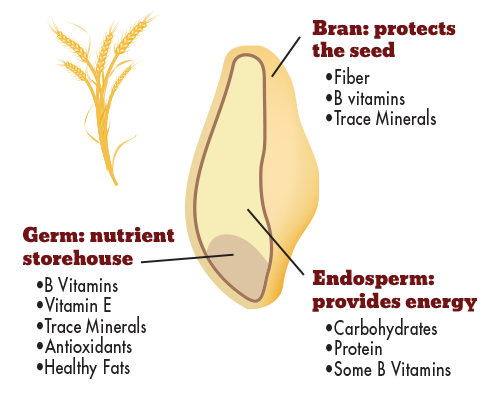Reading food labels
Introduction
Healthy choice is first – understanding what the food you are going to it is made of and what impact it will do to your body. There is a plenty of open sources on the internet explaining the meaning of information given in food labels. Please use any search engine to find and study basics. However, when it comes to store and buying of products, it is often difficult to understand which one is better, healthier and why. This article is designed to give very simple, short but meaningful knowledge and practical advice on how to choose different products using information, given in the label.
Reading labels of food made of grains (very simple view on how to choose grain products)
It all starts with understanding of how the grain looks like and what it brings to our body. Please find the picture No. 6 below to study the simple structure of the grain.

It is obvious, that all parts of the grain are useful and have meaningful impact in terms of nutritional value. Many products like bread for instance, are made of processed grains – flour. Today, many people still believe, that all what is made from flour has to many calories and must be avoided as unhealthy. It is a myth, which is busted, because according the Worlds Health Organization carbohydrates (which make the biggest part of the flour) must be the main source of energy and make 55-65 % of the daily meal of a human. It’s clear therefore, that quitting flour is not a way to be healthier. The main attention must be payed to the quality of flour, meaning the fullness of the grain used to produce the flour – how grain was processed before grinding. Most of cakes, bread rolls, muffins and biscuits and pasta are made using “white” flour. Its is made from grains containing too little or no bran (please look at the picture No. 6 above). Bran brings very important nutrients. Most important is fiber, vitamins and minerals. Fiber is the one, which does not allow carbohydrates to be absorbed to the blood too quickly. Fiber reduces the speed of this process, preventing the body from insulin spikes. Fiber makes quick carbohydrates into slow ones.
So, here is the point. Healthy carbohydrates are the ones not harming our endocrine system, the ones which are absorbed slowly. Unhealthy ones are quickly absorbed. So, healthy flour is the one made of the whole grain (containing whole or big enough amount of bran with fiber).
Unfortunately, bakers rarely use whole grain flour to produce biscuits and other temptation-like products. Because whole grain flour makes it hard, darker and not easy to digest.
How to use information in the label to get understanding if grain product is healthy enough? Search for two parameters to match: amount of fiber in grams in 100 g of the product (nor in a serving or portion, but in 100 g), and amount of sugar in grams in 100 g of the product.
It will be easier if you will remember 5 fingers rule. The rule says – if grain product label shows not less than 5 g of fiber in 100 g of the product and not more than 5 g sugar in 100 g – it’s a healthy choice. This choice will help you consume better products made of flour, because the bran of the grain is there, at least the biggest part of it.
If the label does not show fiber (and you are sure you are studying grain product), it is recommended to skip the product and search for alternative containing needed information.
Calories and fats in grain products do not make any larger sense to study and consider in terms of general usage of this kind of food (bread, flour, groats) and applied to humans not having any disease related to disfunction of pancreas (like diabetes) or liver (dyslipidemia). In case of the disease in place, the above recommendations must be aligned with specific diet first.
Reading labels of food made of milk
In terms of nutritional value fresh milk and fermented milk products are a good source or animal protein, calcium and good bacteria (only valid for fermented milk products). However, very often in production of milk manufactures use a lot of added sugar in a form of jam, syrup etc. Therefore, calories and fats shall not be of primary worry while consuming milk product, unless body has any diseases mentioned above. Amount of added sugar must be considered first.
Simply check how much sugar is in 100 g or ml or the product. All milk products (except those without lactose) contain natural sugar (not added) – lactose. In milk, yogurt, kefir lactose makes 2-5 g/100 g of the product. It is an acceptable amount and should be considered as healthy choice. However, if the label shows more than 5 g of sugar per 100 g of the product, it means there is added sugar and it is recommended to skip the choice. Please read more about harmful impact of exceeded sugar in the next menu item “Consumption of sugar”.